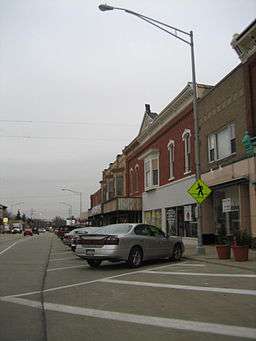Marengo, Illinois
| Marengo | |
| City | |
 Buildings in downtown Marengo. | |
| Motto: Home of Settlers Days | |
| Country | United States |
|---|---|
| State | Illinois |
| County | McHenry |
| Township | Marengo, Seneca, Coral, Riley |
| Elevation | 833 ft (254 m) |
| Coordinates | 42°15′03″N 88°36′18″W / 42.25083°N 88.60500°WCoordinates: 42°15′03″N 88°36′18″W / 42.25083°N 88.60500°W |
| Area | 5.01 sq mi (13 km2) |
| - land | 5.01 sq mi (13 km2) |
| - water | 0.00 sq mi (0 km2) |
| Population | 7,648 (2010) |
| Density | 1,598.5/sq mi (617/km2) |
| Founded | 1835 |
| Mayor | Donald Lockhart |
| Timezone | CST (UTC-6) |
| - summer (DST) | CDT (UTC-5) |
| Postal code | 60152 |
| Area code | 815 |
|
Location of Marengo within Illinois | |
| Wikimedia Commons: Marengo, Illinois | |
| Website: http://www.cityofmarengo.com/ | |
Marengo is a city in McHenry County, Illinois, United States. The population was 7,648 at the 2010 census.
Geography
Marengo is located at 42°15′3″N 88°36′18″W / 42.25083°N 88.60500°W.[1]
According to the 2010 census, Marengo has a total area of 5.01 square miles (12.98 km2), all land.[2]
Major streets
-
 Grant Highway
Grant Highway -
 State Street
State Street -
 Telegraph Street
Telegraph Street
History
Marengo was first called Pleasant Grove, from a grove of trees near the town site.[3] The present name commemorates the Battle of Marengo.[3] A post office called Marengo was established in 1844.[4]
Government
Marengo is governed by the mayor, Donald Lockhart, and a city council of eight aldermen.
Demographics
| Historical population | |||
|---|---|---|---|
| Census | Pop. | %± | |
| 1860 | 1,119 | — | |
| 1870 | 1,327 | 18.6% | |
| 1880 | 1,264 | −4.7% | |
| 1890 | 1,445 | 14.3% | |
| 1900 | 2,005 | 38.8% | |
| 1910 | 1,936 | −3.4% | |
| 1920 | 1,758 | −9.2% | |
| 1930 | 1,948 | 10.8% | |
| 1940 | 2,034 | 4.4% | |
| 1950 | 2,726 | 34.0% | |
| 1960 | 3,568 | 30.9% | |
| 1970 | 4,235 | 18.7% | |
| 1980 | 4,361 | 3.0% | |
| 1990 | 4,768 | 9.3% | |
| 2000 | 6,355 | 33.3% | |
| 2010 | 7,648 | 20.3% | |
| Est. 2015 | 7,503 | [5] | −1.9% |
As of the census[7] of 2000, there were 6,355 people, 2,387 households, and 1,694 families residing in the city. The population density was 1,598.5 people per square mile (616.5/km²). There were 2,475 housing units at an average density of 622.6 per square mile (240.1/km²). The racial makeup of the city was 92.07% White, 0.30% African American, 0.27% Native American, 0.28% Asian, 0.02% Pacific Islander, 5.54% from other races, and 1.53% from two or more races. Hispanic or Latino of any race were 13.00% of the population.
There were 2,387 households out of which 38.6% had children under the age of 18 living with them, 55.9% were married couples living together, 10.7% had a female householder with no husband present, and 29.0% were non-families. 24.9% of all households were made up of individuals and 9.8% had someone living alone who was 65 years of age or older. The average household size was 2.64 and the average family size was 3.17.
In the city the population was spread out with 29.3% under the age of 18, 8.6% from 18 to 24, 31.0% from 25 to 44, 19.2% from 45 to 64, and 12.0% who were 65 years of age or older. The median age was 34 years. For every 100 females there were 96.3 males. For every 100 females age 18 and over, there were 94.3 males.
The median income for a household in the city was $50,214, and the median income for a family was $57,209. Males had a median income of $41,298 versus $26,317 for females. The per capita income for the city was $22,225. About 3.9% of families and 4.4% of the population were below the poverty line, including 5.4% of those under age 18 and 5.5% of those age 65 or over.
Notable people
- Egbert Van Alstyne, songwriter
- David Boies, lawyer and Chairman of Boies, Schiller & Flexner, and lawyer for Al Gore in Bush v. Gore
- Jack D. Franks, Illinois state senator
- Carl Lundgren, pitcher for the Chicago Cubs (1902–1909); born in Marengo
- Edward D. Shurtleff, Illinois state legislator, jurist; served as mayor of Marengo
- Sherman E. Smalley, Wisconsin state assemblyman and jurist; born in Marengo
Media
The Marengo-Union Times is the newspaper of record in Marengo, IL. It has a circulation of 6,300 and is mailed to every home and business in the greater Marengo and Union, Illinois area.
References
- ↑ "US Gazetteer files: 2010, 2000, and 1990". United States Census Bureau. 2011-02-12. Retrieved 2011-04-23.
- ↑ "G001 - Geographic Identifiers - 2010 Census Summary File 1". United States Census Bureau. Retrieved 2015-12-27.
- 1 2 Chicago and North Western Railway Company (1908). A History of the Origin of the Place Names Connected with the Chicago & North Western and Chicago, St. Paul, Minneapolis & Omaha Railways. p. 98.
- ↑ "McHenry County". Jim Forte Postal History. Retrieved 22 March 2015.
- ↑ "Annual Estimates of the Resident Population for Incorporated Places: April 1, 2010 to July 1, 2015". Retrieved July 2, 2016.
- ↑ "Census of Population and Housing". Census.gov. Retrieved June 4, 2015.
- ↑ "American FactFinder". United States Census Bureau. Retrieved 2008-01-31.
External links
- Marengo official website
- The Marengo-Union Times local newspaper website
- Marengo Township Early History
- Marengo Early History
